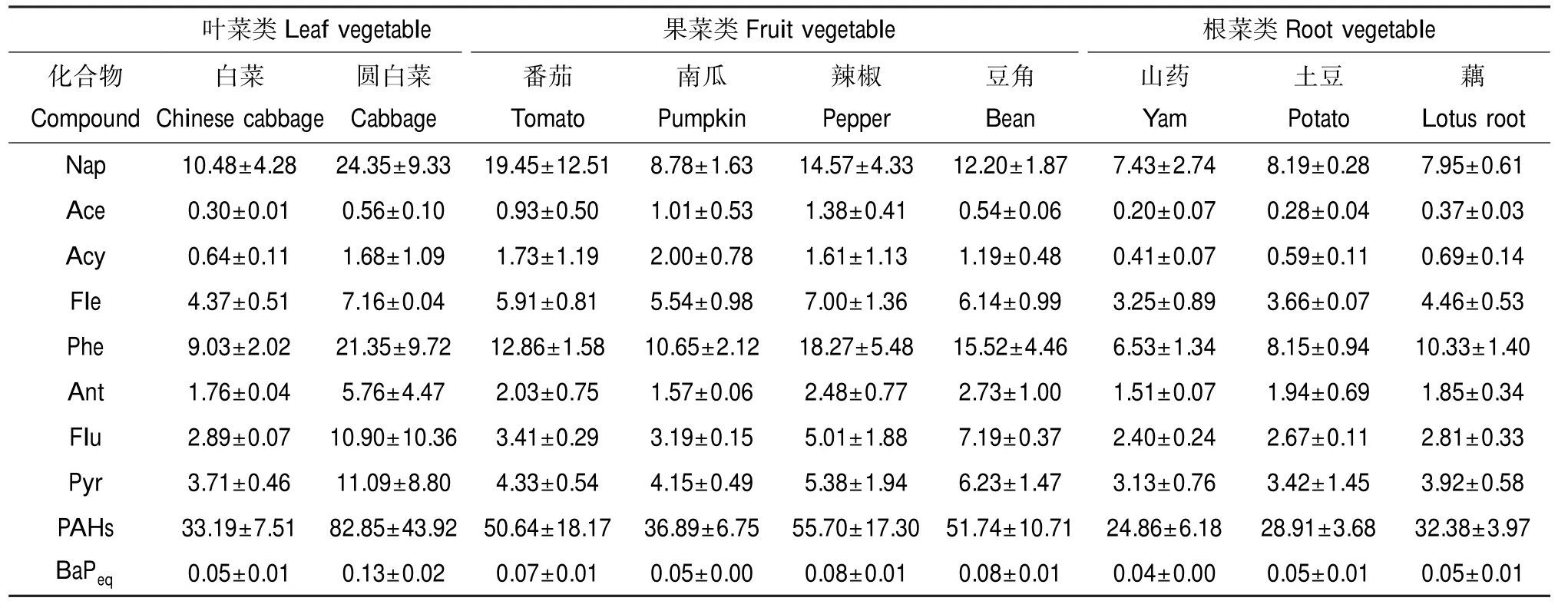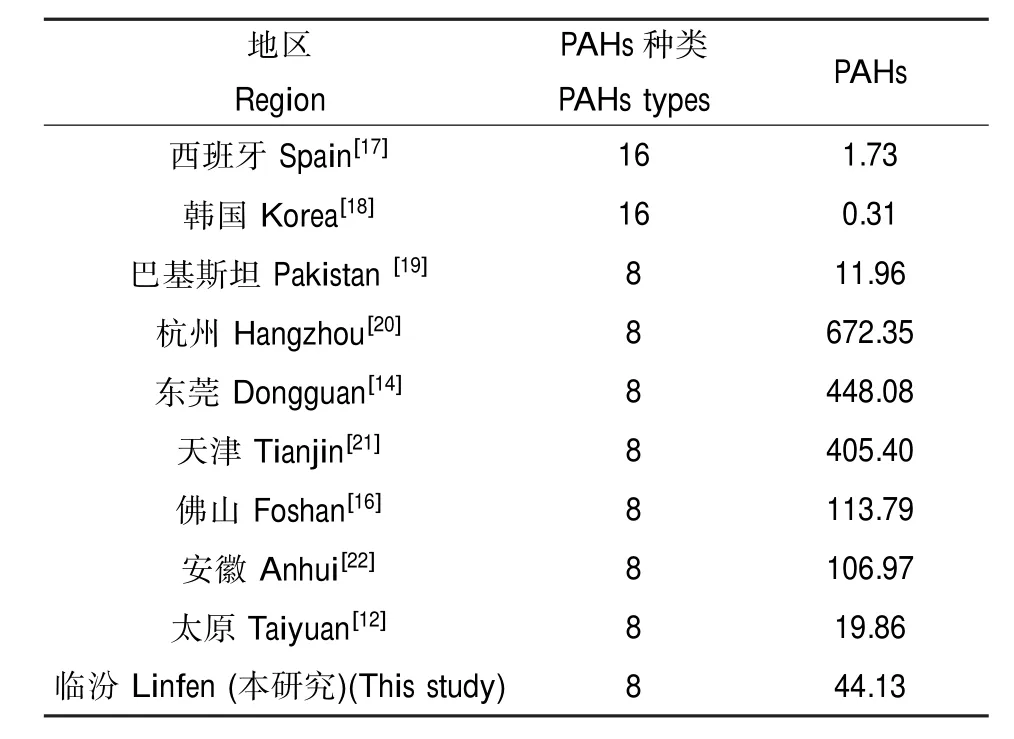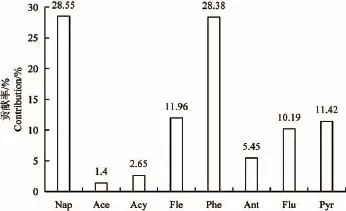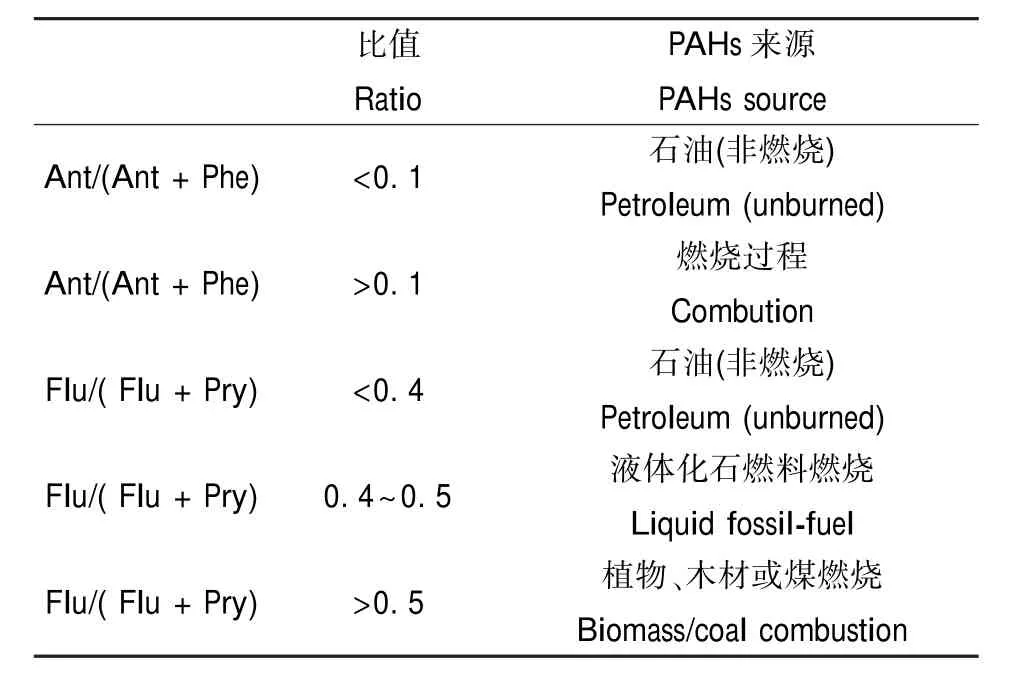临汾市售蔬菜中多环芳烃污染特征及致癌风险分析
殷婧,夏忠欢,3,4,*,周彦池,吴敏敏,张倩倩,杨浩
1.江苏省物质循环与污染控制重点实验室,南京师范大学环境学院,南京210023
2.虚拟地理环境教育部重点实验室(南京师范大学),南京210023
3.江苏省地理信息资源开发与利用协同创新中心,南京210023
4.江苏省地理环境演化国家重点实验室培育建设点,南京210023
临汾市售蔬菜中多环芳烃污染特征及致癌风险分析
殷婧1,2,夏忠欢1,2,3,4,*,周彦池1,2,吴敏敏1,2,张倩倩1,2,杨浩2
1.江苏省物质循环与污染控制重点实验室,南京师范大学环境学院,南京210023
2.虚拟地理环境教育部重点实验室(南京师范大学),南京210023
3.江苏省地理信息资源开发与利用协同创新中心,南京210023
4.江苏省地理环境演化国家重点实验室培育建设点,南京210023
为了研究临汾市食物中多环芳烃(PAHs)的污染特征及对人群的健康影响,本研究于2015年1月采集当地居民普遍食用的9种蔬菜,利用气相色谱-质谱联用仪(GC-MS)检测蔬菜中8种多环芳烃(Nap、Ace、Acy、Fle、Phe、Ant、Flu、Pyr)。研究表明,PAHs在9种蔬菜中均有检出,PAHs的总浓度范围是24.86~82.85 ng·g-1,平均为44.13 ng·g-1。其中PAHs含量最高的是圆白菜(82.85 ng·g-1),最低的是山药(24.86 ng·g-1)。通过来源分析发现来源地蔬菜中PAHs主要来源于液体化石燃料燃烧。临汾市不同人群食用蔬菜引起的终身增量致癌风险(ILCR)在1.27×10-6~7.07×10-6范围内,在目前蔬菜消费量下存在潜在致癌风险。
多环芳烃;蔬菜;污染特征;临汾;致癌风险
殷婧,夏忠欢,周彦池,等.临汾市售蔬菜中多环芳烃污染特征及致癌风险分析[J].生态毒理学报,2016,11(3):265-271
Yin J,Xia Z H,Zhou Y C,et al.Characterization and cancer risk assessment of PAHs in vegetables sold in Linfen City,China[J].Asian Journal of Ecotoxicology,2016,11(3):265-271(in Chinese)
多环芳烃(polycyclic aromatic hydrocarbons, PAHs)是一类由两个及两个以上的苯环连在一起,普遍存在于环境中的持久性有机污染物(POPs),主要来源于化石燃料、薪柴或森林等的不完全燃烧和石油类物质的自然挥发[1-2],是重要的环境和食品污染物[3]。PAHs具有“三致”(致癌、致畸、致基因突变)效应,是近年来环境科学研究领域中的热点。PAHs在环境中难以降解,由于其具有半挥发性和脂溶性的特点,因而可以通过大气沉降作用经植物叶片进入植物体内或进入土壤中由植物根系吸收,并在植物体内迁移、代谢和积累,进而通过食物链危害到身体健康。
人体可通过多种途径暴露于PAHs,对于不吸烟的非职业接触人群来说,膳食暴露贡献最大,约占人体日暴露的70%以上[4-5]。蔬菜是人类膳食的重要组成部分,蔬菜质量的好坏直接影响人体健康[6]。PAHs在蔬菜、水果、肉类、油类和蛋奶中均有不同程度的检出[7-8]。因此,开展蔬菜中PAHs的研究对于保证食品安全具有重要意义。
临汾市作为山西乃至全国重要的能源重化工基地,由于高强度污染物的排放和不利的气象条件,已经成为中国PAHs污染最为严重的城市之一[9],PAHs可能已经威胁了当地居民的健康。然而截至目前为止,还没有关于临汾市居民对PAHs暴露风险的研究。因此,本研究采集了临汾市居民日常消费量最大的9种蔬菜:叶菜类(白菜、圆白菜)、果实类(番茄、南瓜、辣椒、豆角)、根菜类(山药、土豆、藕),通过分析蔬菜中8种PAHs(萘、苊、苊烯、芴、菲、蒽、荧蒽、芘)的含量及分布特征,判断临汾市蔬菜中多环芳烃的污染水平及污染源,并进一步评估当地不同人群对蔬菜中多环芳烃的摄食暴露量及所致健康风险,以期为临汾市的蔬菜质量安全管理提供基础资料和科学依据,从而保障居民的饮食安全。
1 材料与方法(Materials and methods)
1.1 仪器和试剂
气相色谱-质谱联用仪(岛津QP-2010日本),微波萃取器(CEM MARS6美国),旋转蒸发仪(R-201上海),台式低速离心机(TDL-40B上海),超声波清洗器(KQ-500B昆山)。8种PAHs混合标样购自德国Dr.Ehrenstorfer公司,乙腈、二氯甲烷、正己烷、丙酮均为色谱纯(南京化学试剂有限公司)。氧化铝、无水硫酸钠、层析用硅胶(80~200目,迪马公司,中国)为分析纯。实验用水为超纯水。
1.2 样品采集
选取临汾市大型农贸市场和超市,于2015年1月采集了当地居民日常消费量最大的9种蔬菜:叶菜类(白菜、圆白菜)、果实类(番茄、南瓜、辣椒、豆角)、根菜类(山药、土豆、藕)。样品密封在样品袋内用冰袋冷藏并快速运回实验室,用超纯水冲净蔬菜表面的土壤和杂物后,用滤纸沾干表面水分,在4℃下保存待分析。
1.3 样品前处理
取食物样品中可食用部分,绞碎后用20 mL乙腈在微波萃取器中提取,萃取条件为:1 200 w、100℃,升温10 min、静态萃取10 min。萃取液经离心机离心3次后,上清液转移至分液漏斗中,用100 mL 4%的Na2SO4溶液和30 mL正己烷萃取2次,2次萃取液合并后用硅胶-氧化铝层析柱净化,将净化后的样品氮吹至1 mL,更换溶剂定容至2 mL进行定量分析。
1.4 分析方法
采用气相色谱-质谱(GC-MS)联用仪分析样品。GC条件:色谱柱为HP-5MS(30 m×0.25 mm i.d.×0.25 μm film thickness,J&K Scientific,U.S.A.),载气为高纯氦气,进样口温度为280℃,不分流进样1 μL。初始温度为50℃(保留1 min),以15℃·min-1的速度升温至180℃,再以5℃·min-1速度继续升至250℃(保留10 min)。MS条件:倍增器电压为1 200 V,离子源温度为230℃,接口温度为280℃,质量扫描范围50~450,EI离子源,70 eV,调谐方式为自动调谐,SIM模式。
使用外标法定量测定了8种PAHs:萘(naphtha-lene,Nap),苊(acenaphthene,Ace),二苊烯(acenaphthylene,Acy),芴(fluorene,Fle),菲(phenanthrene,Phe),蒽(anthracene,Ant),荧蒽(fluoranthene,Flu),芘(pyrene,Pyr)。根据PAHs标准质谱图对照定性,根据色谱峰面积由5点工作曲线法定量。
1.5 质量控制
氧化铝和硅胶使用前在马弗炉(AAF 1100,Carbolite)里经650℃焙烧10 h,然后储存在密封的干燥器中。使用前在130℃活化4 h。所有玻璃仪器经超声波清洗器清洗后,在400℃下烘6 h。将干净的玻璃珠按实际样品的实验程序进行相同的萃取和净化过程,并将测得的PAHs浓度作为实验空白浓度。所有食物样品的PAHs浓度都经过实验空白校正。基质加标回收率除Nap为51.7%,其余的7种PAHs单体在76%~105%。所有样品的浓度没有经过回收率校正;样品方法检测限范围是0.0018~0.0064 ng·g-1湿重。每批样品(10样品)测定1个空白样和1个重复样,并每天重新校准标准曲线。
1.6 BaP等效浓度
计算PAHs混合物的致癌风险,常利用各种PAHs相对苯并[a]芘的毒性等效因子(toxic equivalency factors,TEFs),将混合物浓度转化为等效苯并[a]芘浓度(BaPeq)。本研究采用Nisbet和La Goy推荐的TEFs值[10](表1)。
1.7 摄食暴露量(ED)计算

式中,BEC—蔬菜中8种PAHs的BaPeq的浓度,ng· g-1;Ci—i类PAH的浓度,ng·g-1;TEFi—i类PAH的毒性当量因子。

式中,IR=每天摄食的蔬菜量,g·d-1[11],男性儿童、男性未成年、男性成年人、男性老人、女性儿童、女性未成年、女性成人、女性老人分别为:95.4、146.5、173.0、155.1、99.7、132.0、157.3、135.1 g·d-1。
1.8 终生致癌风险计算
终生致癌风险(incremental lifetime cancer risk,ILCR)通过文献[12]中的参数和公式来计算。

式中,ILCR—人群终生增量致癌风险(无量纲);SF—BaP摄食暴露的致癌斜率因子,算术平均值7.3,mg ·kg-1·d-1[13];ED—摄食暴露量,ng·d-1;ED—暴露年数,a(儿童ED=7;未成年ED=7;成年人ED=43;老年人ED=10);BW—体重,kg;AT—平均寿命,25 550 d;EF—暴露频率,365 d·a-1;CF—转化因子,10-6mg·ng-1。

表1 各类多环芳烃的毒性当量因子Table 1 PAHs and their toxic equivalent factors(TEFs)

表2 临汾市蔬菜样品中PAHs含量及BaPeq(单位:ng·g-1湿重)Table 2 Residue levels of PAHs and BaPeqin various kinds of vegetables in Linfen City(Unit:ng·g-1wet weight)
2 结果与讨论(Results and discussion)
2.1 各类蔬菜中PAHs含量
8种PAHs在所有蔬菜中都有不同程度的检出。表2列出了9种不同蔬菜种类中8种PAHs的含量范围。总浓度PAHs为24.86~82.85 ng·g-1,平均为44.13 ng·g-1。9种蔬菜中,圆白菜(82.85 ng·g-1)可食用部分中PAHs含量最高,其次是辣椒(55.70 ng· g-1),最低的是山药(24.86 ng·g-1)。从表2可知,8种PAHs的平均浓度:圆白菜>辣椒>豆角>番茄>南瓜>白菜>藕>土豆>山药,叶菜类和果菜类高于根菜类,可能是因为叶菜类和果菜类可食用部分接触空气面积大,富集PAHs能力也较强;而根菜类可食用部分的暴露面积或者比表面积都小,PAHs含量相对较低。万开等[14]研究表明蔬菜中的PAHs主要来源于污染物的干湿沉降,而不是通过根系吸收或别的途径。Monica等[15]研究结果认为,蔬菜中莴苣较蕃茄和白菜含有较多的PAHs,较大的叶面积是产生这一结果的直接原因[16]。
与国内外其他地区蔬菜中PAHs含量相比(表3)。临汾市蔬菜中8种PAHs平均含量(44.13 ng·g-1)高于巴基斯坦(11.96 ng·g-1)和太原(20.60 ng·g-1)的,低于安徽(106.97 ng·g-1)、天津(405.40 ng·g-1)的,也低于珠江三角洲典型农业城市的,如东莞(448.08 ng·g-1)和佛山(113.79 ng·g-1),远低于杭州(672.35 ng·g-1)的,这是因为杭州的蔬菜样品来自钢铁工业区附近的农田,PAHs污染严重。临汾市蔬菜中8种PAHs平均含量高于西班牙(1.73 ng·g-1)和韩国(0.31 ng·g-1)蔬菜中16种PAHs的含量。

表3 临汾市蔬菜中PAHs含量与其他地区的比较(单位:ng·g-1湿重)Table 3 Comparison of PAHs concentrations in vegetables among Linfen City and other regions (Unit:ng·g-1wet weight)

图1 临汾市不同蔬菜种类中PAHs化合物分布特征
2.2 蔬菜中PAHs的分布及源解析
从图1可知,临汾蔬菜中PAHs主要由低分子量的Nap(28.55%)、Phe(28.38%)和Fle(11.96%)组成。低分子量PAHs因为正辛醇/水分配系数(lgKow)小,在水中溶解度大,所以易被植物吸收,富集系数高。张天彬等[16]研究珠江三角洲多种蔬菜,同样发现蔬菜中低分子量PAHs(NaP、Phe、Fle、Ant、Pyr)含量较高。陶澍等[21]在天津工业区采集了8种蔬菜,发现蔬菜中低分子量PAHs(Phe、Ant)含量较高,在蔬菜体内有明显的富集趋势。Nadal等[24]在塔拉戈纳省居民住宅区、工业区采集的甜菜中只检测出低分子量的7种PAHs,其他高分子量的PAHs均低于检出限。
PAHs在环境中有较为敏感的协变性,不同来源会产生不同特性的PAHs组分[26],因此,不同环数的PAHs相对丰度及其同分异构体比值可作为判断环境样品中PAHs来源的指示器[27-28]。同分异构体比值,是一种常用的判断多环芳烃来源的方法,对判断各种环境介质(如水、沉积物、空气、土壤和食品等)中PAHs来源都适用[29-30]。9种蔬菜样品中,Ant/ (Ant+Phe)比值大于0.1,表明主要来源是燃烧过程(表4);Flu/(Flu+Pyr)介于0.4~0.5之间,表明液体化石燃烧为PAHs的主要来源(表4)。因此蔬菜中PAHs主要来自液体化石燃料的燃烧。由于本研究是在临汾大型农贸市场和超市采集的蔬菜,其产地广泛,并不一定来自临汾本地蔬菜基地,因此本研究得到蔬菜PAHs污染源是蔬菜来源地的污染源,并不一定是临汾的污染源。
2.3 摄食暴露分析
由于不同性别、不同年龄段的居民对污染物具有不同的敏感性,故将临汾市居民划分为儿童(4~ 10岁)、青少年(11~17岁)、成年人(18~60岁)、老年人(61~70岁)4个亚群。根据临汾居民对蔬菜的摄食量,计算得到4个年龄亚群日平均暴露量:男性儿童为56.496 ng·d-1,女性儿童为59.033 ng·d-1;青少年男性为86.718 ng·d-1,青少年女性为78.104 ng· d-1;成年男性为102.392 ng·d-1,成年女性为93.102 ng·d-1;老年男性为91.813 ng·d-1,老年女性为79.966 ng·d-1(表5)。不同年龄段的暴露量依次为成年男性>成年女性>老年男性>青少年男性>老年女性>青少年女性>女性儿童>男性儿童。在所有年龄段中,男性的暴露量均大于女性,是因为男性的膳食量大于女性,这与其他文献的研究结果一致[12,17,33]。兰州[34]和上海[35]的成年女性的总暴露量大于成年男性,可能是因为这2个地区除了摄食暴露,还研究了不同人群的皮肤暴露,在皮肤暴露途径中,成年女性可能因为洗浴时间长,洗浴频率高,导致暴露量高于成年男性,因而影响了总暴露量。
2.4 致癌风险分析
4个年龄亚群终生增量致癌风险:男性儿童、男性未成年、男性成人、男性老人、女性儿童、女性未成年、女性成人、女性老人分别为1.59×10-6、1.25×10-6、6.84×10-6、1.47×10-6、1.74×10-6、1.28×10-6、7.29×10-6、1.49×10-6(表5)。在平均暴露频率下,4个年龄段人群的摄食暴露致癌风险均在10-6量级,通常致癌风险低于10-6可以认为没有风险,而致癌风险在10-6~10-4之间则被认为存在潜在风险[36-37]。因此可以从表5的结果可以看出临汾市居民因为摄食蔬菜而存在潜在致癌风险。无论是男性还是女性,不同年龄段的ILCR依次为成年人>儿童>老年人>青少年,这与摄食暴露的结果不一致。尽管儿童的摄食暴露量低于青少年和老年人,但因为儿童体重较小,对有毒物质更敏感,故PAHs暴露导致儿童的致癌风险较高。其他研究也发现儿童对于环境污染引起的健康风险更为敏感,其健康问题值得关注[17,18,38]。临汾市居民的致癌风险也存在性别差异,同一年龄段女性的致癌风险要稍高于男性,这主要是由男女之间体重的差异所造成,这与文献中的报道相一致[12,35]。
关于PAHs摄食暴露风险的研究十分有限,Xia[12]报道的太原市儿童、青少年、成年人和老年人的摄食暴露风险分别为1.18×10-5、7.50×10-6、3.96× 10-5、8.00×10-6,临汾市不同人群的摄食暴露风险均低于太原,可能的原因是太原除了采集蔬菜,还采集了肉类、谷物类,肉类和谷物其中PAHs的浓度大于蔬菜。董纪元[35]将上海市居民划分为儿童(0~6岁)、青少年(6~18岁)和成年人(>18岁),计算得到3类人群由于PAHs暴露引起的健康风险为7.20× 10-6、6.13×10-6、4.44×10-6,均高于临汾市。兰州地区[34]男性和女性居民由于PAHs暴露引起的健康风险分别为4.12×10-5和4.80×10-5,高于临汾市。La Daana等[39]研究西印度群岛居民食用水产品引起的致癌风险为8.4×10-6~1.6×10-5,高于临汾市居民的平均风险值2.87×10-6。彭驰等[37]研究得到北京市科教园区内学习、工作的学生和教职工由于吸入、接触或误食绿地土壤中PAHs引起的终生致癌风险均值为1.1×10-6,低于临汾市。

表4 多环芳烃组份比值与其来源的相互关系[31-32]Table 4 PAH ratios and end member values for source diagnosis[31-32]

表5 PAHs的4个年龄段摄食暴露及终生致癌风险评价结果(单位:ng·d-1)Table 5 Dietary exposure and ILCRs of PAHs for four age groups(Unit:ng·d-1)
致谢:感谢崔晓宁先生在临汾采样中给予的帮助。
(References):
[1] 彭驰,王美娥,廖晓兰.城市土壤中多环芳烃分布和风险评价研究进展[J].应用生态学报,2010,21(2):514-522
Peng C,Wang M E,Liao X L,et al.Distribution and risk assessment of polycyclic aromatic hydrocarbons in urban soil[J].Chinese Journal of Applied Ecology,2010,21(2): 514-522(in Chinese)
[2] 江泽利,孙玉川,王尊波,等.降雨期间岩溶地下河溶解态多环芳烃变化特征及来源解析[J].环境科学, 2015,36(11):4088-4093
Jiang Z L,Sun Y C,Wang Z B,et al.Variation characteristics and source of polycyclic aromatic hydrocarbons in Karst subterranean river during rainfall events[J].Environmental Science,2015,36(11):4088-4093(in Chinese)
[3] 于林杰.多环芳烃对环境的污染分析研究[J].环境科学与管理,2014,39(7):73-75
Yu L J.Analysis on environmental pollution characteristics of polycyclic aromatic hydrocarbons[J].Environmental Science and Management,2014,39(7):73-75(in Chinese)
[4] Ibannez R,Agudo A,Berenguer A,et al.Dietary intake of polycyclic aromatic hydrocarbon in Spanish population [J].Food Protection,2005,68(10):2190-2195
[5] 曹梦思,王君,张立实,等.食品中多环芳烃的研究现状[J].卫生研究,2015,44(1):151-157
Cao M S,Wang J,Zhang L S,et al.Research status of polycyclic aromatic hydrocarbons in food[J].Journal of Hygiene Research,2015,44(1):151-157(in Chinese)
[6] 侯媛媛,王礼力.基于主成分分析基础上的中国蔬菜家庭消费预测[J].统计观察,2010,23:91-93
Hou Y Y,Wang L L.Analysis of Chinese household consumption of vegetables based on the prediction[J].Statistics&Decision,2010,23:91-93(in Chinese)
[7] Abramsson-Zetterberg L,Darnerud P O,Wretling S.Low intake of polycyclic aromatic hydrocarbons in Sweden: Results based on market basket data and a barbecue study [J].Food and Chemical Toxicology,2014,74:107-111
[8] Veyranda B,Sirot V,Durand S,et al.Human dietary exposure to polycyclic aromatic hydrocarbons:Results of the second French total diet study[J].Environment International,2013,54:11-17
[9] Zhang Y X,Tao S,Shen H Z,et al.Inhalation exposure to ambient polycyclic aromatic hydrocarbons and lung cancer risk of Chinese population[J].Proceedings of the National Academy of Sciences of the United States of A-merica,2009,106(50):21063-21067
[10] Lan C T,Nisbet I T,Lagoy P K.Toxic equivalency factors (TEFs)for polycyclic aromatic hydrocarbons(PAHs)[J]. Regulatory Toxicology and Pharmacology,1992,16:290-300
[11] 翟凤英,杨晓光.中国居民营养与健康状况调查报告(二):膳食与营养素摄入状况[M].北京:人民卫生出版社,2006:1-288
Qu F Y,Yang X G.Chinese National Health and Nutrition Survey Report Two:Diet and Nutrient Intake Status[M]. Beijing:People's Medical Publishing House,2006:1-288 (in Chinese)
[12] Xia Z H,Duan X L,Qiu W X,et al.Health risk assessment on dietary exposure to polycyclic aromatic hydrocarbons(PAHs)in Taiyuan,China[J].Science of Total Environment,2010,408(22):5331-5337
[13] UnitedStates Environmental Protection Agency(US EPA). Drinking Water Criteria Document for PAHs[R].Washington DC:the Office of Health and Environmental Assessment,Environmental Criteria and Assessment Office, 1991
[14] 万开,江明,杨国义,等.珠江三角洲典型城市蔬菜中多环芳烃分布特征[J].土壤,2009,41(4):583-587
Wan K,Jiang M,Yang G Y,et al.Distribution characteristics of PAHs in vegetables of typical city in Pearl River Delta:A case study of Dongguan City[J].Soils,2009,41 (4):583-587(in Chinese)
[15] Monica C,Rojo C,Maria C.Polycyclic aromatic hydrocarbons in Brazilian vegetables and fruits[J].Food Control,2003,14:49-53
[16] 张天彬,万洪富,杨国义,等.珠江三角洲典型城市农业土壤及蔬菜中的多环芳烃分布[J].环境科学学报, 2008,28(11):2375-2384
Zhang T B,Wan H F,Yang G Y,et al.Distribution of polycyclic aromatic hydrocarbons in agricultural soil and vegetables of Foshan City in the Pearl River Delta[J].Acta Scientiae Circumstantiae,2008,28(11):2375-2384(in Chinese)
[17] Martí-Cid R,Llobet J M,Castell V,et al.Evolution of the dietary exposure to polycyclic aromatic hydrocarbons in Catalonia,Spain[J].Food and Chemical Toxicology, 2008,46:3163-3171
[18] Yoon E,Park K,Lee H,et al.Estimation of excess cancer risk on time-weighted lifetime average daily intake of PAHs from food ingestion[J].Human and Ecological Risk Assessment,2007,13(3):669-680
[19] Mohammad M W,Taqvi S I,Solangi A R,et al.Distribution and risk assessment of polycyclic aromatic hydrocarbons in vegetables grown in Pakistan[J].Journal of Chemistry,2013,32:1-5
[20] 沈菲,朱利中.钢铁工业区附近农田蔬菜PAHs的浓度水平及分布[J].环境科学,2007,28(3):669-672
Shen F,Zhu L Z.Concentration and distribution of PAHs in vegetables grown near an iron and steel industrial area[J]. Environmental Science,2007,28(3):669-672(in Chinese)
[21] Tao S,Cui Y H,Xu F L,et al.Polycyclic aromatic hydrocarbons(PAHs)in agricultural soil and vegetables from Tianjin[J].Science of Total Environment,2004,320:11-24
[22] 郜红建,魏俊岭,马静静,等.安徽省典型城市周边土壤-蔬菜中PAHs的污染特征[J].农业环境科学学报, 2012,31(10):1913-1919
Gao H J,Wei J L,Ma J J,et al.Characteristics of PAHs contamination in soil and vegetable in typical city outskirt of Anhui Province,China[J].Journal of Agro-Environment Science,2012,31(10):1913-1919(in Chinese)
[23] Duare-Davidson R,Jones K C.Screening the environmental fate of organic contaminants in sewage sludge applied to agricultural soilsⅡ:The potential for transfers to plants and grazing animal[J].Science of Total Environment,1996,185:59-70
[24] Nadal M,Schuhmacher M,Domingo J L.Levels of PAHs in soil and vegetation samples from Tarragona County, Spain[J].Environmental Pollution,2004,132:1-22
[25] Larsson B,Sahlberg G.Polycyclic aromatic hydrocarbons in lettuce.Influence of a highway and aluminum smelter [C].Sixth International Symposium on PAH,Battelle Columbus Laboratory,Columbus,OH,1981
[26] Esther V,Joan O G,Ana F S,et al.Transport of persistent organic pollutants across the human placenta[J].Environment International,2014,65:107-115
[27] Ratola N,Alves A,Lacorte S,et al.Distribution and sources of PAHs using three pine species along the Ebro River[J].Environmental Monitoring and Assessment, 2012,184(2):985-999
[28] Yunker M B,Macdonald R W,Vingarzan R,et al.PAHs in the Fraster River basin:A critical appraisal of PAH ratios as indicators of PAH source and composition[J].Organic Geochemistry,2002,33:489-515
[29] Tobiszewski M,Namiesnik J.PAH diagnostic ratios for the identification of pollution emission sources[J].Environmental Pollution,2012,162:110-119
[30] 张桂斋.两类持久性有机污染物和重金属在南四湖食物链中的分布和生物积累[D].济南:山东大学,2014:1-226
Zhang G Z.The distribution and biological accumulation of two kinds of persistent organic pollutants(POPs)and heavy metals in the Nansi lake[D].Jinan:Shandong University,2014:1-226(in Chinese)
[31] Li X H,Ma L L,Liu X F,et al.Polycyclic aromatic hydrocarbon in urban soil from Beijing,China[J].Journal of Environmental Sciences,2006,18(5):944-950
[32] 陈晓,艾芳,吴敏,等.胎盘内多环芳烃分布及源解析研究[J].生态毒理学报,2015,10(4):210-218
Chen X,Ai F,Wu M,et al.Distribution and source apportionment of polycyclic aromatic hydrocarbon in human placentas[J].Asian Journal of Ecotoxicology,2015,10 (4):210-218(in Chinese)
[33] Falco G,Domingo J L,Llobet J M,et al.Polycyclic aromatic hydrocarbons in foods:Human exposure through the diet in Catalonia,Spain[J].Journal of Food Protection,2003,66(12):2325-2331
[34] 董继元,王金玉,张格祥,等.兰州地区人群对多环芳烃的暴露及健康风险评价[J].生态环境学报,2012,21 (2):327-332
Dong J Y,Wang J Y,Zhang G X,et al.Population exposure to PAHs and the health risk assessment in Lanzhou area[J].Ecology and Environmental Science,2012,21(2): 327-332(in Chinese)
[35] 董继元,刘兴荣,张本忠,等.上海市居民暴露于多环芳烃的健康风险评价[J].生态环境学报,2014,24(1): 126-132
Dong J Y,Liu X R,Zhang B Z,et al.Population exposure to PAHs and the health risk assessment in Shanghai area [J].Ecology and Environmental Science,2014,24(1): 126-132(in Chinese)
[36] Liao C M,Chiang K C.Probabilistic risk assessment for personal exposure to carcinogenic polycyclic aromatic hydrocarbons in Taiwanese temples[J].Chemosphere,2006, 63(9):1610-1619
[37] 彭驰,王美娥,欧阳志云,等.北京科教园区绿地土壤中多环芳烃的残留特征与潜在风险[J].环境科学, 2012,33(2):592-598
Peng C,Wang M E,Ouyang Z Y,et al.Characterization and potential risk of polycyclic aromatic hydrocarbons in green space soil of education area in Beijng[J].Environmental Science,2012,33(2):592-598(in Chinese)
[38] 李新荣.天津地区多环芳烃的排放、扩散和人群暴露的空间分异暴露[D].北京:北京大学,2007:1-152
Li X R.Spatial distribution pattern of emission,dispersion and exposure of polycyclic aromatic hydrocarbons in Tianjin,China[D].Beijing:Peking University,2007:1-152(in Chinese)
[39] La Daana K,Gobin J F,Beckles D M,et al.Polycyclic aromatic hydrocarbons(PAHs)inCrassostrea rhizophorae andCathorops spixiifrom the Caroni Swamp,Trinidad, West Indies[J].Environment Science and Pollution Research,2015,22(2):1366-1379◆
Characterization and Cancer Risk Assessment of PAHs in Vegetables Sold in Linfen City,China
Yin Jing1,2,Xia Zhonghuan1,2,3,4,*,Zhou Yanchi1,2,Wu Minmin1,2,Zhang Qianqian1,2,Yang Hao2
1.Jiangsu Provincial Key Laboratory of Materials Cycling and Pollution Control,School of Environment,Nanjing Normal University, Nanjing 210023,China
2.Key Laboratory of Virtual Geographic Environment(Nanjing Normal University),Ministry of Education,Nanjing 210023,China
3.Jiangsu Center for Collaborative Innovation in Geographical Information Resource Development and Application,Nanjing 210023,China
4.State Key Laboratory Cultivation Base of Geographical Environmental Evolution(Jiangsu Province),Nanjing 21003,China
27 November 2015 accepted 3 February 2016
In order to determine the pollution characteristics of polycyclic aromatic hydrocarbons(PAHs)in food and assess the consequent health effects of the population in Linfen,nine kinds of vegetables were commercially collected from the markets of Linfen in January 2015,which are widely consumed by local residents.Concentrations of eight PAHs(Nap,Ace,Acy,Fle,Phe,Ant,Flu and Pyr)were quantified using gas chromatography-massspectrometry(GC-MS).PAHs were detectable in all kinds of vegetables,and the total PAHs concentrations ranged from 24.86 ng·g-1to 82.85 ng·g-1,with a mean of 44.13 ng·g-1.The highest level of total PAHs was detected in cabbage(82.85 ng·g-1)whereas the lowest concentration was found in yam(24.86 ng·g-1).Source analysis suggested that liquid fossil-fuel combustion mainly contributed to the concentration of PAHs.The incremental lifetime cancer risk(ILCR)ranged from 1.27×10-6to 7.07×10-6,indicating a potential carcinogenic risk for local residents under the current consumption amount of vegetables.
PAHs;vegetables;pollution characteristics;Linfen;cancer ris
2015-11-27 录用日期:2016-02-03
1673-5897(2016)3-265-07
X171.5
A
10.7524/AJE.1673-5897.20151127004
简介:夏忠欢(1978—),男,博士后,副教授,主要研究方向为污染物的环境行为以及生态与健康风险评价。
国家自然科学基金项目(41001344);中国博士后科学基金项目(2013M541696);江苏省博士后科研资助计划项目(1301040C);江苏省高校自然科学研究项目(13KJB610008);环境基准与风险评估国家重点实验室课题(SKLECRA2013OFP07);南京师范大学高层次人才科研启动基金项目(2012105XGQ0102);南京师范大学研究生教育教学改革研究与实践课题(1812000002A521);江苏高校优势学科建设工程资助项目(164320H116)
殷婧(1989—),女,硕士研究生,研究方向为污染物的环境行为及生态与健康风险评价,E-mail:yinjing1989@163.com
*通讯作者(Corresponding author),E-mail:zhhxia@njnu.edu.cn

